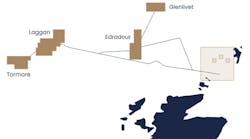Installation of the pipelines and landfall for Shell's Goldeneye project is nearing the midway point. Goldeneye is a gas-condensate field situated in 120 m of water in the Outer Moray Firth, off northeast Scotland. The field is being developed via a wellhead platform, with production piped through a 20-in., 105-km multiphase line direct to Shell's process terminal at St. Fergus.
The installation, being performed by Saipem laybarge Castoro Sei, represents a UK distance record for a full-wellstream tieback. The work scope was recently expanded to include BG's Atlantic and Amerada Hess' Cromarty gas-condensate fields, which lie 80-km northeast of St. Fergus. These fields are being developed with subsea facilities, with commingled output also piped directly to St. Fergus through an 80-km, 18-in. line.
Combined gas reserves for the three fields are estimated at over 730 bcf. In parallel with the two export lines, MEG lines are being installed (4-in. for Goldeneye and 6-in. for Atlantic/Cromarty). Inhibitors will be pumped through these from the terminal to the Goldeneye platform, where they will be injected into the wellstream to suppress hydrate formation temperatures within the export lines.
For the shore approach sections, both MEG lines piggyback on their respective export lines. Van Oord ACZ, using its multipurpose pontoon Manta, is managing pull-in/landfall operations. This eight-year-old vessel was converted in 1997 for duties including pipelay, pipe pull, and dredging.
Prior to the pull-in for this project, preparatory work established the pull profile for both sets of pipelines. These included:
null
- A temporary crossing of the Winterloch area, a depression between the outer and inner dunes which is normally flooded in winter but dry in summer
- Making a cut in one of the primary sand dunes, then using the sand to build a causeway running from the outer to the inner dunes and up the escarpment before the terminal for the onshore section of the pipelines
- Installation of two cofferdams, both 130 m long and 6 m wide.
Once the cofferdams were in place, two sets of 92-mm steel pull wires were set down from the beach to a point 900 m out at sea, ready for pick-up by the Castoro 6 and subsequent connection to the pipeline end sections. Installation (pull-out) of the two sets of wires was handled from the Manta. Two 350-ton linear winches located on the beach at St. Fergus were deployed simultaneously for the pull-in operations, both pipelines having been pulled ashore. (In fact, the highest pull force that had to be exerted was 370 tons). This work was completed over an eight-day period in May.
The next task was to trench and bury the landfall approach sections of the lines, using the subcontractor's Sumatran Tiger trenching machine. This month-long operation, completed in early July, represented the trencher's first application in a North Sea project. Progress was reasonably good, according to Van Oord ACZ, although the seabed soils and rock underneath turned out to be tougher than expected.
Subsequently, the contractor set about extracting the cofferdams and restoring the dunes to their previous state, followed by installation of the final 400-m section of the Goldeneye lines across the beach to St. Fergus, which was also Van Oord ACZ's responsibility. The onshore pipes will be protected with an FBE coating and sacrificial anodes.
At press time, no decision had been reached on the reception terminal for the Atlantic/Cromarty pipelines. Van Oord ACZ's contracted completion date for the entire project is end-October.




